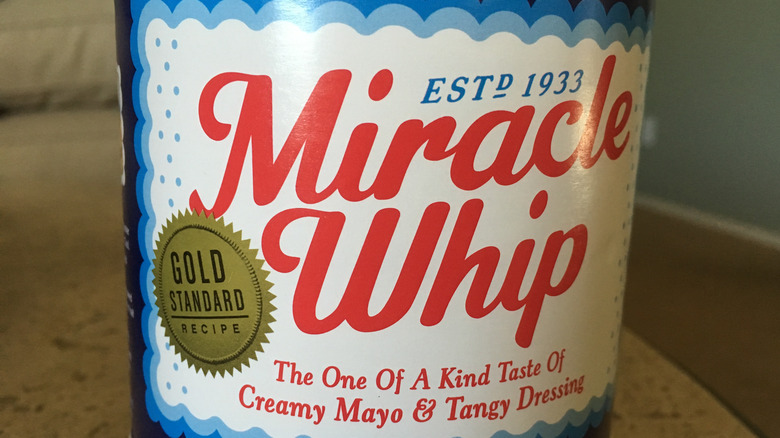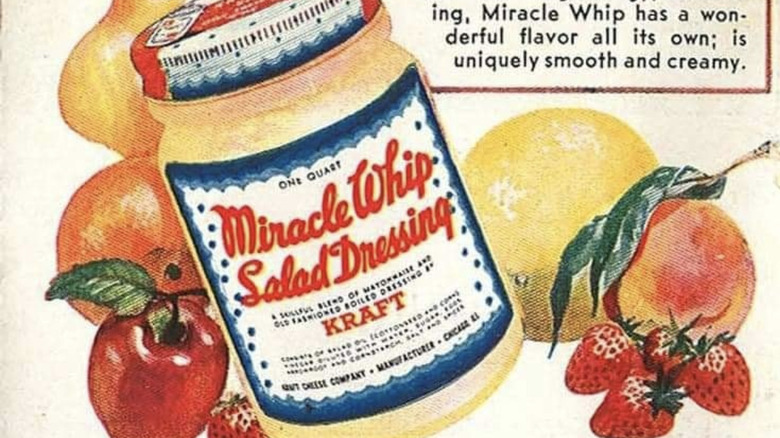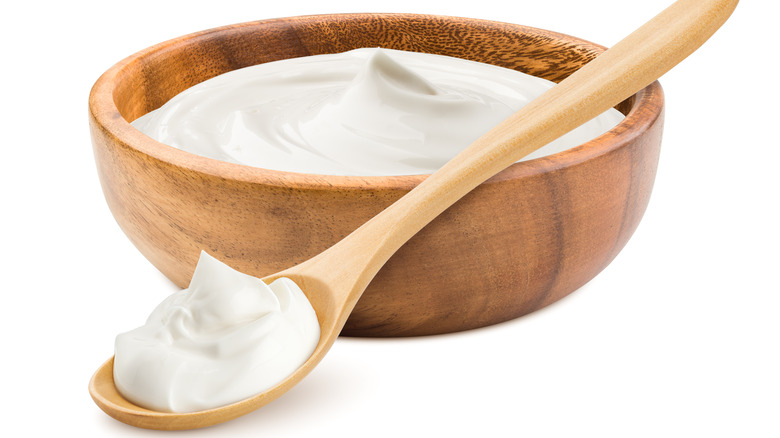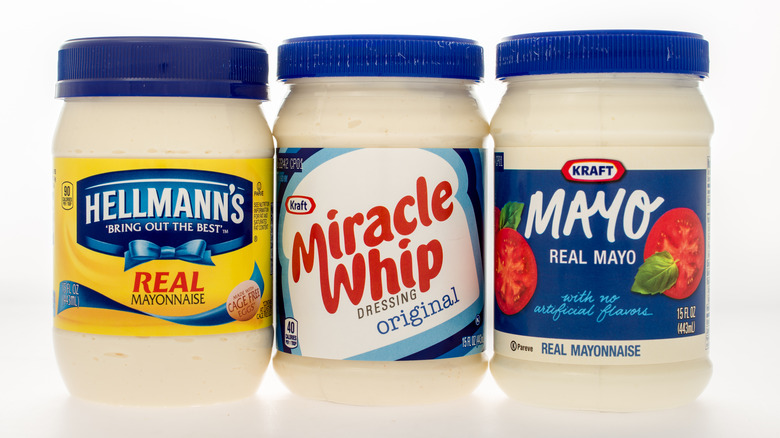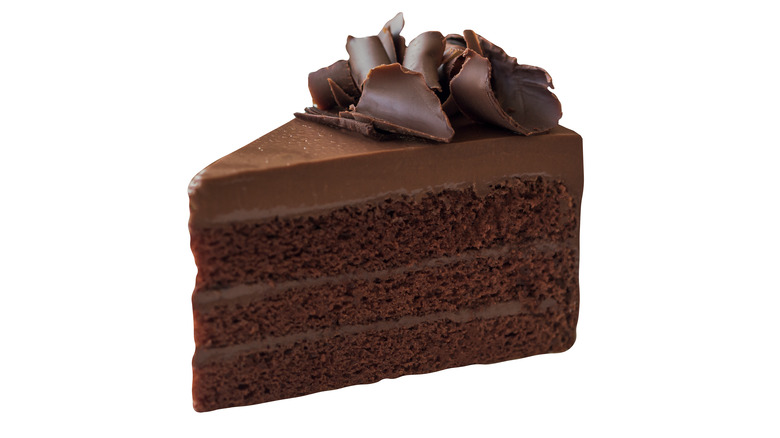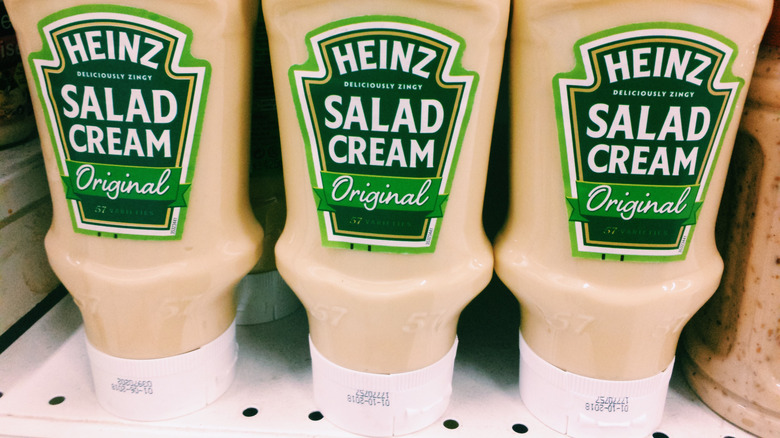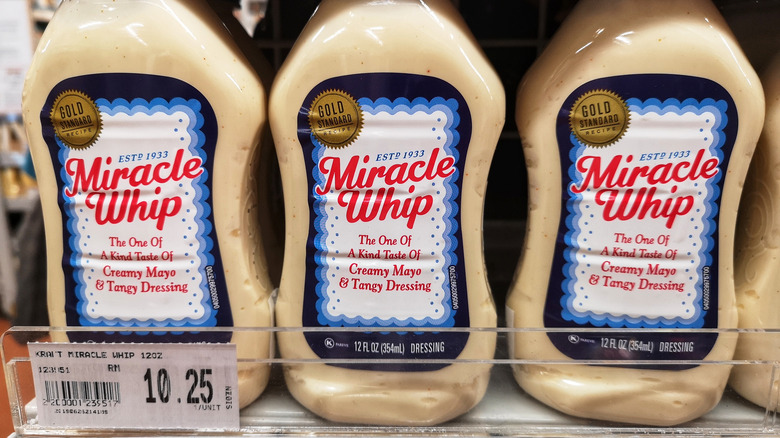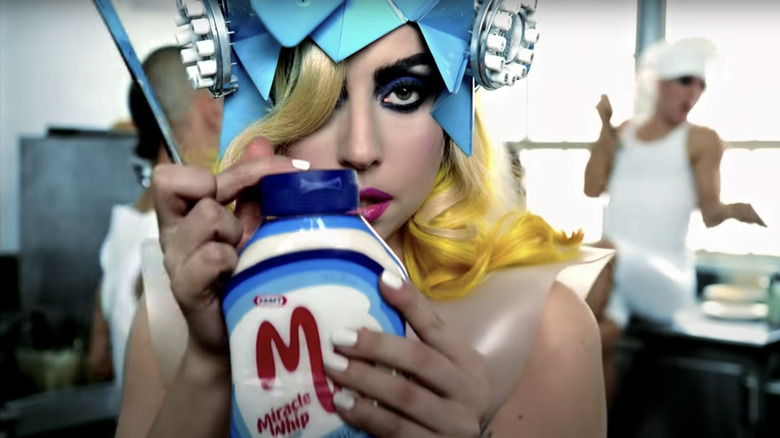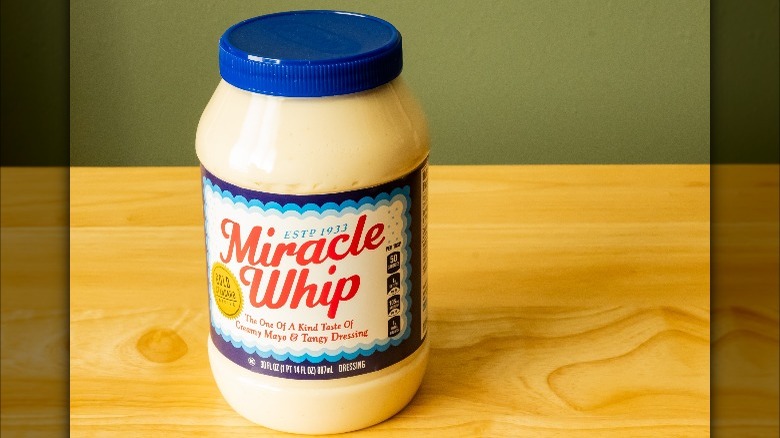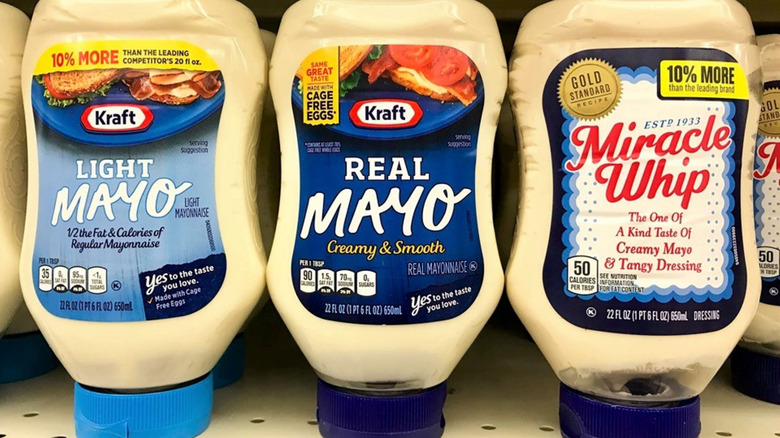The Untold Truth Of Miracle Whip
It's creamy. It's white. It's slathered all over your turkey sandwich. It's ... not mayonnaise. No, today we're talking about mayonnaise's sweeter, spicier, and all-American little sibling: Miracle Whip. You can make mayonnaise at home, but Kraft needed a special machine (called, not coincidentally, a Miracle Whip) to develop the emulsified, fluffy "salad dressing" loved by millions of Americans (and probably loathed by just as many). Miracle Whip is a product of America's love affair with industrialized food in the 20th century, much like Jell-O salads and Kraft macaroni & cheese.
Miracle Whip's journey has taken it from the Chicago World's Fair to the fridges of Depression-era America to a co-starring role in a Lady Gaga music video. It may not be everybody's cup of tea, but you certainly couldn't accuse it of being boring. Whether you like Miracle Whip's distinctive taste or prefer the comforting creaminess of mayonnaise (or like both in different contexts) this spread's story is one worth telling.
It debuted at the 1933 World's Fair
According to Kraft's official history, Miracle Whip's first public appearance was at the 1933 World's Fair. Per Dining Chicago, that fair was dubbed the Century of Progress Exposition. Held in Chicago's Northerly Island, the Exposition was meant to showcase the wondrous products and innovations American industry was able to create (via Encyclopedia of Chicago). Its other purpose was to distract Americans from the hardships of the Great Depression and show that there were still positive developments happening in the world. Kraft's futuristic, industrially-made mayonnaise replacement would have fit right in with the consumer paradise the Exposition was selling to the public.
There is an alternate history of Miracle Whip as well. According to Salem, Illinois' website, Kraft actually bought the recipe for the dressing from the Salem restaurant Max Crossett's Cafe in 1931. Dining Chicago clarifies that this origin story is just a myth and that Kraft developed Miracle Whip in-house. There is a nugget of truth to the story, however: When Kraft decided to develop a jarred mayonnaise, the company bought several recipes from smaller businesses in order to perfect its own product.
Miracle Whip was a surprising hit during the Great Depression
Kraft actually started making mayonnaise before it developed Miracle Whip. The company's mayonnaise business dates back to 1926 (via Grog to Grits). While mayonnaise did well for Kraft at first, the onset of the Great Depression tanked the condiment's sales. With households looking to save money wherever possible, many people realized it was cheaper to just make mayo at home instead of buying the jarred stuff.
The sudden drop in mayo sales inspired Kraft to come up with a product that was mayo-like that the company could sell at a higher profit margin. According to Dining Chicago, a Kraft employee named Charles Chapman invented a machine that could emulsify different ingredients together into a creamy mixture. This machine, which Kraft displayed at the Century of Progress Exposition alongside its new mayo substitute, was called the Miracle Whip, which is how the spread got its name. Kraft's mayonnaise alternative was an instant success, becoming the nation's best-selling salad dressing within half a year of its debut (yes, it was marketed as a salad dressing).
It's a riff on boiled salad dressing
Although Miracle Whip was in some ways an innovative product at the time it was released, it was also based on a very old-fashioned food. Miracle Whip is basically a blend of mayonnaise and boiled salad dressing (via Dining Chicago). Although you don't see homemade boiled dressing on many dinner tables these days, it used to be a household staple. According to Cook's Info, in the days before mass-produced vegetable oil (a necessary ingredient for making mayonnaise) or jarred mayonnaise was widely available, boiled dressing was the easiest, most cost-effective way for cooks to make a creamy, mayo-like sauce at home.
Although there are many variations on boiled dressing, it always starts with a base of eggs and vinegar emulsified with some kind of liquid — generally water, milk, or cream. This mixture is seasoned with sugar, salt, and spices, then cooked until thick. Often, a little starch is added as well to thicken the mixture even more and stabilize the emulsion.
Miracle Whip is not mayonnaise
Miracle Whip contains many of the same ingredients as mayonnaise, like eggs, oil, and vinegar, but it cannot legally be sold as mayo in the U.S. The main difference between Miracle Whip and mayonnaise comes down to the amount of oil that is used. The U.S. Food and Drug Administration mandates that mayonnaise must be at least 65% oil. Miracle Whip falls below that threshold, which is why it's labeled as dressing instead of mayo.
Although it can't legally be called mayonnaise, Miracle Whip can be used in pretty much any context you would use mayonnaise in, from spreading on sandwiches to dressing potato salad. However, dishes made with Miracle Whip will not taste the same as if you made them with mayo. Miracle Whip has a distinctively tangy flavor with more sweetness than traditional mayo, and that taste will come through in your recipes. It's also more assertively seasoned with spices, so its flavor is less neutral than that of traditional mayonnaise.
You can put it in cake
Miracle Whip may be sweet, but it's not really dessert-level sweet. It still definitely tastes like something you'd want in a creamy salad or on a sandwich rather than something you'd add to a dessert. Despite this fact, creative home cooks have found a way to put Miracle Whip in places you'd never expect. One example is this recipe for Miracle Whip chocolate cake written by a homemaker living in Texas sometime in the mid-20th century (via Texas Hill Country). The instructions say to beat the Miracle Whip and sugar together to start the batter, with the Miracle Whip taking the place of a more traditional fat source like butter or oil.
We would guess that Miracle Whip cake is an offshoot of mayonnaise chocolate cake, a World War II-era invention that allowed cooks to make dessert during a time when fresh ingredients may have been hard to come by. The Texas Hill Country Miracle Whip chocolate cake recipe appears to come from this tradition, as it requires no butter or eggs.
Miracle Whip has a British cousin
America doesn't have a monopoly on packaged mayo-like salad dressings. According to Cook's Info, the U.K. is mad about salad cream, a bottled boiled dressing. Salad cream actually predates Miracle Whip by a couple of decades. Per The Guardian, Heinz released the product in 1914 after a long period of research and experimentation. It was Heinz's first U.K.-exclusive food.
Salad cream became solidified as a major component of the British diet during World War II when ketchup was scarce. It helped make dull meals cooked with rationed ingredients taste a little bit more interesting. However, in more recent times, real mayonnaise has become more popular in Britain. Heinz was actually considering ending salad cream production in 2000, but public outcry caused the company to reverse its decision. Heinz also stoked consumer outrage when it tried to rename salad cream to sandwich cream in 2018. After the vast majority of customers opposed the change, Heinz decided to stick with the salad cream name (via the Daily Mail).
Much like Miracle Whip, salad cream is tangier and lower in fat than mayonnaise, with more vinegar and less oil and egg.
The town of Mayo, Florida changed its name to Miracle Whip
Mayo, Florida is a tiny city that serves as the seat of government in Lafayette county (via WCTV). Although the town is actually named after a Confederate colonel and not the creamy egg-based spread, Kraft still saw Mayo's name as a marketing opportunity. The company paid up to $25,000 to temporarily rename the town Miracle Whip as a marketing stunt. The original plan was to secretly change the town's signage and surprise its residents with the Miracle Whip rebranding. Kraft even wanted to send a camera crew to the town to film humorous attempts to confiscate the mayonnaise from residents' fridges and replace it with Miracle Whip.
However, the plan ran into a few snags. For one, as anyone who grew up in a town with under 2,000 people can tell you, it's almost impossible to keep secrets in a community of that size. Also, Mayo's city council may have actually violated state law by meeting with representatives from Kraft in secret. All city council meetings in the Sunshine State are supposed to be open to the public.
Mayo may have possibly sold its naming rights too cheaply as well. Granville, North Dakota, sold its name to the schnapps company McGillicuddy (formerly the makers of Fireball) for the princely sum of $100,000 way back in the 1990s. That sure makes it seem like Kraft got a great deal by offering only $15,000-$25,000 to Mayo.
Miracle Whip got into a battle with Stephen Colbert
This saga is from before Stephen Colbert was delivering jokes on "The Late Show." Back in 2009, when the comedian was still embodying a right-wing blowhard persona on "The Colbert Report," he aired a segment making fun of a Miracle Whip commercial (via Brent Campbell). The ad tried to paint the brand as a fun, hip, non-conformist alternative to mayonnaise. We have to admit that the commercial feels like it's trying pretty hard to make Miracle Whip seem cool, and we're not sure it's succeeding. Colbert created a parody of the commercial for his show that extolled the virtues of mayonnaise instead of Miracle Whip.
Sensing an opportunity for more brand exposure, Miracle Whip sent a sternly-worded letter to Colbert admonishing him for being on the wrong side of the mayo vs. Miracle Whip fight. The brand vowed to get back at him by appearing during every commercial break of one episode of his show. The company did just that, and it even created a re-edited version of the ad that mocked Colbert.
The brand paid to be in a Lady Gaga video
It seems like Miracle Whip was really trying hard to be cool in 2009-2010. Not only did it air that "Don't be so mayo" commercial and pick a fight with Stephen Colbert, but it also paid an undisclosed sum of money to feature prominently in Lady Gaga and Beyoncé's 2010 video for "Telephone."
The video certainly aligns with Miracle Whip's then-current slogan, "We will not tone it down" (via Ad Age). In it, Gaga whips up poisonous food to kill Tyrese Gibson (as well as a crowd of people in a diner). While this is happening, she and a team of backup dancers also make some Wonder Bread and Miracle Whip sandwiches. Wonder Bread didn't have to pay to appear in the video, which doesn't seem fair to us (though Miracle Whip is certainly shown more prominently in the video than Wonder Bread is). We're not exactly sure how watching a murderer use the product was supposed to sell more Miracle Whip, but the video did act as a debut for the product's redesigned packaging, so we suppose it wasn't a total loss.
Miracle Whip's taste is divisive
If you've never had Miracle Whip before, you might be surprised (in a bad way) by its sweet, tangy flavor. On the other hand, the spread has passionate defenders who insist that it's better than mayo. This Quora thread starts with the question, "Why does Miracle Whip taste bad?" Many commenters chime in with the observation that taste is personal. Most of the Miracle Whip defenders claim they grew up eating it, so your stance on Miracle Whip versus mayonnaise appears to be strongly influenced by what your parents bought when you were a kid.
Over on the Ask An American subreddit, one user posed the inquiry, "What does Miracle Whip taste like?" Many of the replies were negative, calling the spread "nasty," "disgusting," and "like fermented mayonnaise." Miracle Whip even divides families, with several posters saying that their households were split between Miracle Whip lovers and haters. Just like the Quora thread, however, many people jumped to Miracle Whip's defense, calling it "far superior" to mayonnaise and praising its distinctive tang.
Miracle Whip has less than half the calories of mayonnaise
While the culinary merits of Miracle Whip may be subjective, there's no room for arguing about the hard numbers of its nutritional facts. In pure caloric terms, Miracle Whip is significantly lighter than Kraft mayo, coming in at a mere 40 calories per 1-tablespoon serving versus mayo's 90 calories. Miracle Whip is also lower in fat and saturated fat, with 3.5 grams and 0.5 grams of each per serving. In contrast, mayonnaise has 10 grams of fat, 1.5 grams of which are saturated.
Of course, nutritional value can't be measured in fat and calories alone. As you would expect given its sweet taste, Miracle Whip has more sugar than mayonnaise. And while Kraft mayo is made with regular granulated sugar, Miracle Whip uses high fructose corn syrup, which may be worse for you. That said, there's still only one gram of sugar in each serving of Miracle Whip, so the sugar content probably isn't a huge concern unless you're dead-set on eliminating high fructose corn syrup from your diet or are avoiding carbs entirely.
